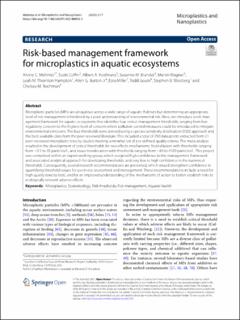| dc.contributor.author | Mehinto, Alvine | |
| dc.contributor.author | Coffin, Scott | |
| dc.contributor.author | Koelmans, A.A. | |
| dc.contributor.author | Brandner, S. | |
| dc.contributor.author | Wagner, Martin | |
| dc.contributor.author | Thornton Hampton, Leah | |
| dc.contributor.author | Burton, Allen G. | |
| dc.contributor.author | Miller, E. | |
| dc.contributor.author | Gouin, Todd | |
| dc.contributor.author | Weisberg, S.B. | |
| dc.contributor.author | Rochman, Chelsea | |
| dc.date.accessioned | 2023-02-09T10:25:46Z | |
| dc.date.available | 2023-02-09T10:25:46Z | |
| dc.date.created | 2023-01-17T15:41:43Z | |
| dc.date.issued | 2022 | |
| dc.identifier.issn | 2662-4966 | |
| dc.identifier.uri | https://hdl.handle.net/11250/3049599 | |
| dc.description.abstract | Microplastic particles (MPs) are ubiquitous across a wide range of aquatic habitats but determining an appropriate level of risk management is hindered by a poor understanding of environmental risk. Here, we introduce a risk management framework for aquatic ecosystems that identifies four critical management thresholds, ranging from low regulatory concern to the highest level of concern where pollution control measures could be introduced to mitigate environmental emissions. The four thresholds were derived using a species sensitivity distribution (SSD) approach and the best available data from the peer-reviewed literature. This included a total of 290 data points extracted from 21 peer-reviewed microplastic toxicity studies meeting a minimal set of pre-defined quality criteria. The meta-analysis resulted in the development of critical thresholds for two effects mechanisms: food dilution with thresholds ranging from ~ 0.5 to 35 particles/L, and tissue translocation with thresholds ranging from ~ 60 to 4100 particles/L. This project was completed within an expert working group, which assigned high confidence to the management framework and associated analytical approach for developing thresholds, and very low to high confidence in the numerical thresholds. Consequently, several research recommendations are presented, which would strengthen confidence in quantifying threshold values for use in risk assessment and management. These recommendations include a need for high quality toxicity tests, and for an improved understanding of the mechanisms of action to better establish links to ecologically relevant adverse effects. | en_US |
| dc.language.iso | eng | en_US |
| dc.publisher | Springer Nature | en_US |
| dc.rights | Navngivelse 4.0 Internasjonal | * |
| dc.rights.uri | http://creativecommons.org/licenses/by/4.0/deed.no | * |
| dc.title | Risk-based management framework for microplastics in aquatic ecosystems | en_US |
| dc.title.alternative | Risk-based management framework for microplastics in aquatic ecosystems | en_US |
| dc.type | Peer reviewed | en_US |
| dc.type | Journal article | en_US |
| dc.description.version | publishedVersion | en_US |
| dc.source.volume | 2 | en_US |
| dc.source.journal | Microplastics and Nanoplastics | en_US |
| dc.identifier.doi | 10.1186/s43591-022-00033-3 | |
| dc.identifier.cristin | 2108788 | |
| dc.source.articlenumber | 17 | en_US |
| cristin.ispublished | true | |
| cristin.fulltext | original | |
| cristin.qualitycode | 1 | |

